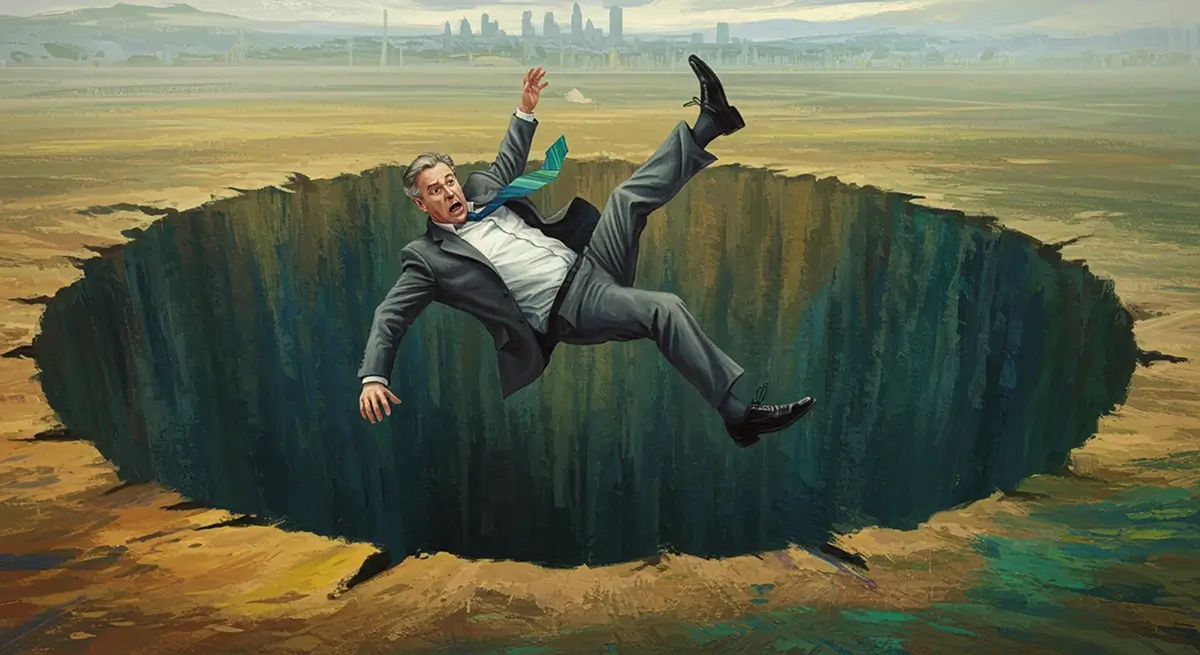Organizational ManagementOrganizational Strategy
Weathering The Storm: Can Your Company Survive Recessions?
TABLE OF CONTENTS
Key Takeaways
- Discover the main indicators and signs that signal when a recession is looming.
- Understand common triggers—like rising costs or faltering consumer confidence—that can destabilize entire markets.
- Learn how government policies and careful financial management can help lessen the hardships of downturns.
- See why past recessions can guide better planning for both short-term shocks and eventual recovery.
- Recognize how well-timed innovation and smarter spending choices can boost resilience and long-term growth.
Economic recessions are periods defined by a broad decline in economic activity, often lasting for several months or even years. These episodes of economic contraction can push businesses and households into difficult conditions. While some experts will only classify a period of economic downturn as a recession after two consecutive quarters of shrinking gross domestic product, the National Bureau of Economic Research looks at additional elements such as industrial production trends and shifts in consumer spending.
When these signs worsen across multiple sectors, sales and profits may slide. In response, worried consumers often become more cautious, and employers may cut staff or reduce output, causing further drops in consumer confidence. Throughout the global economy, this process can accelerate rapidly, as shown during the COVID-19 slowdown of 2020. The pandemic forced widespread business closures, disrupted supply chains, and led to swift job cuts, which hurt real income and delayed the economy’s quick recovery.
Understanding Recessions Through Historical Context
Looking at past recessions provides clues about their causes and patterns.
“Over the past four decades, events like the great recession of 2007–2009 and earlier crises have helped economists and policymakers refine their approaches to dealing with economic downturn phases.”
The bureau tracks recessions in the United States, evaluating data on industrial production, consumer demand, and more. Meanwhile, the International Monetary Fund observes worldwide trends that shape the global economy.
Historically, recessions have ranged from a relatively mild recession in 2001 to more severe “economic collapses” like the period between 2007 and 2009, with the Great Recession. The latter was sparked by the collapse of mortgage-related assets in the financial markets, which then led to a deep financial crisis.
Because the U.S. stands as the world’s largest economy, the effects rippled outward. Another well-known downturn was the great depression, which severely disrupted national output and caused enormous unemployment. Although the National Bureau of Economic Research finds differences in each case, one shared feature is a significant decline in economic activity that can hurt industries for years after the decline.
Recognizing the Causes of Recessions
An economic recession can arise from multiple economic factors, sometimes overlapping in unexpected ways. Modern economic research highlights several underlying forces that can create economic downturn conditions.
Demand Shocks and Shifting Consumer Behavior
One major cause of recessions is a sudden drop in consumer confidence and aggregate demand. Households may cut spending on non-essentials, pulling back on dining out or big-ticket goods. When sales dip enough, many firms reduce payroll, further weakening economic activity. If this pattern persists, it can create lower demand across entire supply chains. This type of decline especially impacts small businesses with thin margins that cannot handle lost revenue for extended periods.
Supply Chain Disruptions and Rising Resource Costs
Another trigger for recessions can be increased resource costs or disruptions in crucial inputs. Oil prices are a classic example: if they soar, shipping and manufacturing costs climb, threatening profit margins. If factories cannot obtain materials, production levels fall. Such disruptions can prompt a decline in economic activity across multiple industries. Natural disasters, trade conflicts, or sudden regional crises often heighten these risks.
Financial Market Turmoil and Credit Freezes
Problems in the financial sector can also spark recessions. During boom periods, lenders might grant excessive credit, leading to financial risks when growth cools. Rising default rates may prompt banks to cut new lending, leaving firms without capital. Households likewise curtail spending if credit dries up. The great recession of 2007–2009 shows how financial factors can escalate quickly when financial market problems reach a breaking point, ultimately damaging economies around the globe.
External Events: Health Crises and Worldwide Disruptions
Recessions are not only triggered by internal economic factors but also external forces like pandemics, extreme weather, or political instability. These can lead to a global recession if they curb travel, close factories, and hinder external demand. The COVID-19 episode stalled entire regions, driving unemployment higher in both developing and advanced economies. Even as some areas recovered faster, the toll on businesses revealed how fragile integrated supply chains and cross-border commerce can be.
Key Indicators for Spotting a Recession
Economists and leaders track various metrics to determine when a recession begins, how long it might last, and whether it might evolve into a more severe recession.
Industrial Production and Employment Trends
Falling factory output often appears first. If orders contract, producers reduce hours or halt expansions, causing industrial production to drop. This leads to job losses and can push the unemployment rate upward. A mild recession might see joblessness climb from four to seven percent, whereas a more dire phase can exceed double digits. Labor statistics help identify whether layoffs are isolated or more widespread, offering an early sense of how hard recessions could hit.
Interest Rates, Monetary Policies, and Government Signals
Central banks like the Federal Reserve routinely adjust interest rates to address inflation or an economic downturn. If the Federal Reserve sets rates too high, borrowing slows, while a sharp cut can aim to spark lending. Policymakers also watch tax revenues and budget deficits for signs of distress. Larger deficits may indicate increased government spending, meant to stabilize the economy. Shifts in federal funds rate policy can show whether authorities want to stimulate or restrain growth, influencing how fast recessions might deepen or reverse. Consumer expectations can also affect spending if the outlook becomes grim.
Consumer Spending, Real Income, and GDP Growth
Consumer demand is a prime driver of economic progress. If real income falls, families reduce discretionary purchases. Analysts look at overall consumer spending to measure how these changes affect sales, particularly in service industries. A sustained fall in economic output, often measured over two consecutive quarters, signals a recession. Yet the National Bureau examines data beyond just GDP, including personal income or wholesale figures, before pronouncing a downturn. This wider lens helps in business cycle insights and in predicting recessions earlier.
Commodity Prices and Global Trade Patterns
Resource-heavy sectors watch for shifts in raw material costs. If factories slash orders for energy or metals, it can hint at weakening production. Although oil prices may climb or fall based on demand, similar fluctuations in steel or aluminum are equally telling. With reduced shipping volumes, many analysts foresee a drop in cross-border activity, often heralding cutbacks in manufacturing. Meanwhile, changes in asset prices, especially in major stock markets, can reflect growing fear among investors. A bear market may intensify concerns that recessions happen soon, prompting businesses and households to brace for more challenges.
Are We in a Recession?
Not all experts agree on when a recession begins, as data can arrive slowly and different sectors respond at different speeds. However, once consecutive quarters of negative output, weakening consumer sentiment, and tighter credit appear, the economy is probably in decline. Spotting economic activity spread from one industry to another reinforces the likelihood of recession. Timely awareness can reduce negative impacts, allowing companies to pivot or hold cash until conditions stabilize.
Strategic Management During Recessions
As recessions loom, policymakers and business leaders attempt to soften their effects. In many nations, officials rely on fiscal and monetary policies to combat widespread financial strain, while corporations adopt internal measures to survive.
Public Sector Responses
National governments may launch infrastructure programs or expand relief efforts, funding these moves through higher budget deficits if necessary. According to the Congressional Research Service, these initiatives can preserve jobs and help keep consumer confidence from collapsing. The Federal Reserve Bank or the International Monetary Fund might buy troubled assets, hoping to reassure banks and sidestep a sharper credit crunch. Though such interventions can be controversial, they often aim to prevent more extreme disruptions, such as a sharp recession that lingers.
Corporate Adjustments and Financial Prudence
Businesses often reassess budgets when recessions threaten, cutting big expansions or shelving new product lines can curb expenses.
“Although downsizing might help in the short term, managers must balance immediate savings with the need to stay competitive once the economy revives.”
Keeping an eye on credit markets is essential: as interest rates shift or the money supply tightens, even profitable ventures can stall if loans dry up. Companies that trim unnecessary costs but retain core teams often emerge readier for the next upswing. Rising inflation can also influence corporate decisions, as higher costs of materials reduce margins.
Early Warning Systems and Managing Financial Risks
An advantage in recessions is identifying trouble early. By watching monthly sales data, industry forecasts, and broader monetary policies, executives can scale back before conditions worsen. For instance, they might limit inventory or streamline shipping processes if consumer orders appear to be dropping. This proactive approach helps maintain public trust and shields a company’s finances from rash moves later. Businesses that maintain stable operations during tough times are typically better placed to recover once global trade and global growth reaccelerate.
The Role of Management Style and Workforce Stability
Recessions can spark financial difficulties among companies, creating anxiety for employees. Leadership style matters: executives who share clear updates about pay adjustments or departmental restructures are more likely to preserve morale. If layoffs become necessary, transparent timelines and severance help maintain some goodwill. A creative culture may also reveal ways to trim costs or add revenue streams. By encouraging staff input, management might discover overlooked opportunities. In times of crisis, open dialogue can sustain productivity and reduce friction, leading to a healthier rebound.
Business Strategies: Preparing, Responding, and Thriving
Different companies feel recessions in different ways—some fold quickly under pressure, while others adapt and uncover new niches. Taking steps in finance, operations, and customer outreach can limit the fallout and position organizations for long-term gains.
Planning and Preparation Before a Recession
Experts often stress early planning for recessions. A cash reserve covering a few months of expenses can be critical if sales collapse. Keeping debt manageable avoids crushing interest costs. Monitoring signs like rising unemployment or changes in interest rates can alert leaders to developing threats.
“Scenario planning also aids readiness: managers can model revenue drops of 20 percent or more, deciding in advance which costs to reduce.”
Diversifying across product lines or geographic markets lowers exposure if one segment falters. Firms that spread risk stand a better chance of riding out wide-ranging declines in demand. Observing the business cycle as it moves through expansion and contraction periods is equally important.
When planning for a recession remember these key points:
- Maintain a cash reserve sufficient for several months
- Watch for warning signs like increased unemployment or rising interest rates
- Diversify product lines or regions to spread risk
- Practice regular scenario planning for potential revenue drops
Financial Resilience: Cash Flow and Cost Management
During recessions, close supervision of cash flow becomes vital. Reviewing weekly inflows helps ensure bills get paid while renegotiating supplier terms might unlock more liquidity. One approach is to trim unproductive spending without undermining future growth. Removing entire marketing or R&D budgets can backfire since a total pullback might reduce visibility and hamper a quick comeback when the country produces new trade opportunities. A balanced plan that cuts needless spending yet sustains essential projects typically works best.
Leadership, Communication, and Workforce Management
Teams often worry about job security and pay when recessions deepen. Leaders who provide consistent updates on financial health and possible cutbacks can maintain trust. If layoffs are required, fair treatment and robust communication help retain those who stay. Keeping top performers is vital for developing new offerings once demand revives.
Employees might also propose cost-saving measures, from reorganizing workflows to adopting new technology. A sense of shared responsibility can keep morale higher, even in a shaky environment. Unemployment insurance offers a buffer for workers who lose positions, but how management handles these changes can influence company culture long after the crisis ends.
Customer Retention and Market Strategy in a Downturn
When money is limited, both individuals and businesses curb optional purchases first. Adapting pricing and offering smaller bundles or discounts can preserve client relationships. However, cutting marketing to zero may be unwise, as it can erase brand visibility during times when competitors might also scale back. Maintaining a moderate promotional presence can help a firm stand out and claim a bigger market share. Some organizations find new consumer groups or pivot to online channels, capturing opportunities that arise when others withdraw. The goal is to reassure existing customers that the company can meet changing needs, which can foster loyalty beyond the recession.
Innovation and Diversification: Finding Opportunity in the Downturn
“Downturns, though difficult, sometimes motivate businesses to reevaluate old assumptions and pursue new ideas.”
A lean budget often drives creative thinking, because teams must accomplish the same goals with fewer resources. Bear markets (a market in which stock prices begin to lose value and people tend to sell) can drive innovation and diversification during downturns. Some established companies with healthy cash positions consider acquisitions during recessions, as asset prices may drop. By acquiring smaller competitors or complementary technologies, they can strengthen their market position for the long term.
Diversification of offerings also helps if it lines up with genuine consumer demand. Shoppers might become more cost-conscious, but they could still pay for products that ease their stress or fill a pressing need. For investors seeking safer returns, downturns present a chance to shift money to stable sectors, government bonds, or well-balanced portfolios. Although returns might be lower, they may also be steadier, which can shield them from the worst market swings. Stock market fluctuations can create opportunities for diversification. All of these actions show how a recession, though troubling, can serve as a launching point for new models and lines of business.
Thriving Through Recessions
Recessions happen repeatedly throughout economic cycles. Although their timing is uncertain, understanding their origins, indicators, and management tools can help businesses navigate these challenging times. Researchers at the International Monetary Fund and the National Bureau of Economic Research emphasize how data on commodity prices, labor conditions, and spending patterns can offer clues about oncoming slumps.
“In many advanced economies, policymakers use fiscal and monetary policies to cushion the effects, while companies adjust strategies to minimize losses.”
Drawing lessons from the great depression and the Great Recession, we see that crises can spark large shifts in policy and corporate behavior. Firms that adopt early warning systems, maintain solid cash buffers and preserve good customer relationships often emerge stronger. The average recession length varies, but planning can make a big difference in how well a business weathers the storm.
By paying attention to changing unemployment rate data, refining cost structures, and offering relevant solutions to a cautious public, organizations can position themselves to handle even a deep recession. Once the economy reaches a healthier phase, those who invest in talent, innovation, and loyal clients can capture new opportunities. Indeed, while recessions can be daunting, they also provide a chance for prudent companies to refine operations and secure lasting growth.










